|
Zebra (Xplore Technologies) L10 Rugged Tablet Platform
Zebra evolves its compact Windows tablet into a versatile, scaleable platform of lightweight tablets, hard-handle tablets, and 2-in-1 hybrids
(by Conrad H. Blickenstorfer, with photography by Carol Cotton — also see PDF version of this review here)
Share on:




On June 19, 2018, Zebra Technologies Corp. introduced their next generation rugged tablet platform, the L10. We're referring to the L10 as a platform rather than just a product because it actually comes in three form factors. These are a pure tablet (XSLATE L10), a version with hard handle and an optional integrated barcode reader for ergonomic all-day data capture (XPAD L10), and a 2-in-1 designed to be a full laptop replacement (XBOOK L10).
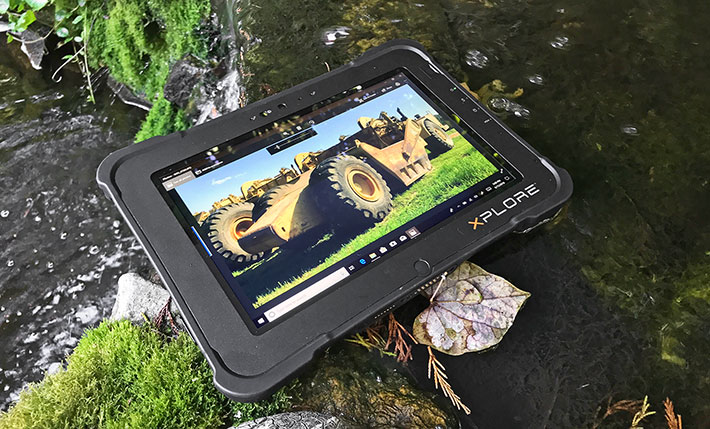
First a few words about Xplore Technologies Corp. of Austin, Texas (which is now part of Zebra). They have been making rugged tablet computers for over two decades and they have sold hundreds of thousands of them. It all started with the GeneSys line of ultra-ruggeds. In 2003 came the anvil-tough iX104 family that is now in its 6th generation. In 2013 Xplore introduced the Android-based RangerX tablet, followed by the Bobcat, a Windows version of the same platform. In early 2015 Xplore took over Motion Computing and added that tablet pioneer's experience and their R12 and C5/F5 tablet products. Then came the XSLATEs B10 and D10, updated and more powerful versions of the Bobcat and RangerX. Last year Xplore pioneered the use of PCIe storage in rugged tablets. There's a long history of of good design and innovation.
The reason for the new L10 platform was to take the popular XSLATE B10 and not only enhance and improve it with state-of-the-art technology, but evolve it into a comprehensive tablet ecosystem covering a wide range of performance and functionality demands. Hence this new trio of very rugged mobile computers for the field and use under the harshest conditions, and all sharing the same extensions, add-ons and accessories.
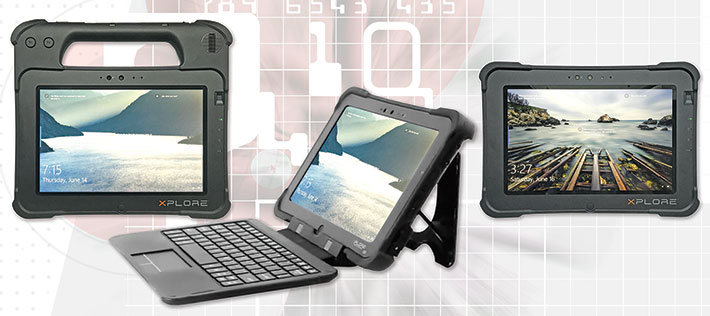
How the L10 platform evolved from the XSLATE B10
For those familiar with the current Xplore Windows-based B10 and Android-based D10 (and the earlier Bobcat and RangerX) rugged tablet computers, the the new L10 platform looks largely the same (outside, anyway), but it has been improved and reworked in many areas:
- Design: Looking at the new tablet from the front, top and bottom, you'd first think the new L10 and the existing B10 are virtually identical. But Xplore actually changed the display aspect ratio from 16:9 to 16:10, and the XSLATE B10's carbon fiber bezel has given way to solid very dark gray throughout the device. Plus there are numerous small design changes. The hard handle of the XPAD version isn't just a bolt-on. It is a separate cohesive design. The XBOOK, on the other hand, mostly represents the addition of keyboard and kickstand to a standard XSLATE L10.
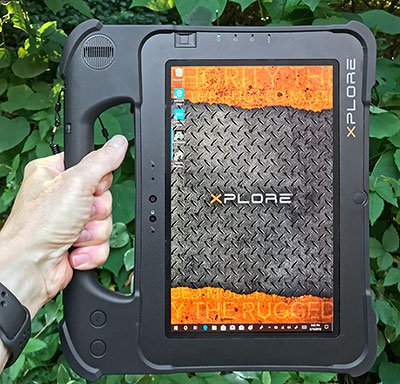 - Performance: Very big difference here. The B10 and its lower-end Bobcat sibling were quick machines, but time moves on. Instead of continuing with two different Windows models with different performance, Xplore now offers four performance levels in the same machine. On the high end, the L10 leaps ahead a full three Intel Core processor generations, from 5th ("Broadwell") to 8th ("Kaby Lake R"). On the low end, there is a two generation jump from "Bay Trail" to "Apollo Lake" (both of the Intel Atom lineage).
- Graphics: The Intel HD Graphics 505 graphics integrated in the Pentium N4200 processors available for the low-end L10 is a GT1 tier version of the Intel Processor Graphics Gen 9 generation and includes 18 Execution Units. The Intel UHD Graphics 620 graphics integrated in the Core processors available for the L10 are GT2 tier versions of the Intel Processor Graphics Gen 9 generation, include 24 Execution Units, and run at higher speeds.
- Memory and storage: Depending on the processor version, L10 units get from 4GB to 16GB of RAM, with 16GB only available in Core units. Solid state disk capacity is 128GB, but SSDs up to 256GB are available. For mass storage, the Pentium version is limited to SATA SSDs up to 512GB; the Core versions may opt for much faster PCIe-based SSDs up to 1TB. The microSD card slot remains externally accessible.
- USB Type C: In addition to two USB 3.0 ports, the L10 also gets a USB-C port with its smaller, reversible connector. The USB-C port supports the USB 2.0, USB 3.0 and DisplayPort out standards.
- Wireless: Wireless communications is much faster now. There's an Intel Dual Band Wireless-AC 8265 + Bluetooth V4.2. And the optional 4G LTE mobile broadband module — which supports LTE-A Pro, CAT-12, and Dual Sim (the L10 has two nanoSIM sockets) — delivers up to 600% faster download and 300% faster upload than earlier generations.
- Camera: The XSLATE L10 provides still/video documentation with a new and higher resolution cameras. It's now 13-megapixel in the rear, and a front-facing FHD 2-megapixel webcam for conferencing and video calls.
- Display: The 10.1-inch wide-format IPS display remains unchanged in diagonal size, but it's now 16:10 instead of 16:9 aspect ratio. It still uses direct bonding, has perfect horizontal and vertical viewing angles, and is available in 500 or 1000 nit backlight versions to provide excellent outdoor viewability. Another big step forward is boosting display resolution from the B10's 768 x 1366 pixel to 1920 x 1200 pixel. That means going from 155 to 224 pixels per inch for a very noticeable increase in sharpness.
- Touch: The L10 uses projected capacitive 10-finger multi-touch with automatic mode switching to glove and wet conditions. In addition to touch, two different active pen versions are available, those being the battery-powered ePen and the time-proven Wacom technology active pen for writing, drawing, annotating and anything that needs more precision than finger touch.
- Battery: The main battery now snaps into the body of the L10, making it much quicker and easier to swap for a fresh one. The standard battery packs 36 watt-hours, with a battery life claim up to 10 hours). There a much more powerful 98 watt-hour optional extended battery that boosts battery life up to 27 hours.
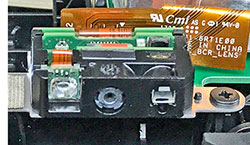
- Ruggedness: The L10 is even more rugged than its predecessors. It can now handle 6-foot drops. IP65 sealing carries over, and as before, external ports are sealed on the inside, too. This means water won't leak in even if those ports are left open.
- HDMI: The tablet has an optional full-size HDMI-in port.
- Legacy ports: The L10 has an optional dedicated true RS232 port.
- Scanning: The XPAD version can be ordered with a 1D/2D integrated scanner located in the hard handle.
Design and implementation
As far as physical specifications go, the standard L10 tablet, like the earlier B10, measures 11.1 x 7.7 inches (281 x 195 mm) and is 0.85 inches (22 mm) thick. The hard handle XPAD version is 2.3 inches taller (11.1 x 10.0 inches) and weighs 3.26 pounds.
As for materials, the L10 platform has a polycarbonate plastic housing with elastomer edge and corner protection over an internal magnesium alloy frame. It makes for an elegant and distinctive look that's purposeful, functional, and ergonomic.
The Xplore L10 is designed to guard against dust and liquids getting inside, something that's most easily accomplished with as few external ports and openings as possible. However, some onboard connectivity is needed in a tablet to provide functionality in the field, and Xplore has always offered a balance of onboard and docking connectivity. The L10 platform is no exception and offers generous connectivity for a rugged tablet. Below you can see the hard handle version of the Xplore L10, the XPAD L10, from the front and all four sides:
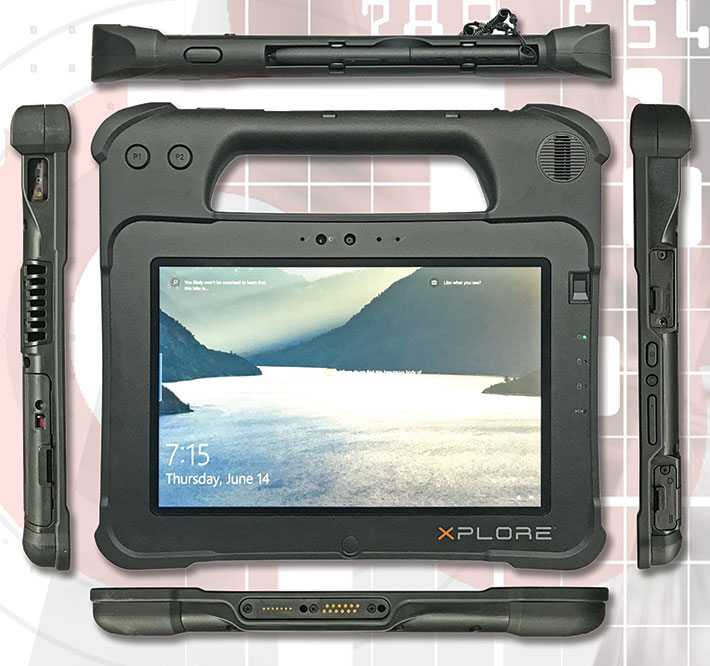
The front view shows that Xplore designed the tablet to primarily be used in landscape mode, but it also quickly snaps into landscape or even upside down mode if the tablet is turned. For hardware controls, there's an unmarked physical Windows button in the bottom center of the face. Above the display is the camera, the ambient light sensor, as well as dual microphones. To the right of the screen are four small indicator lights and the unit's fingerprint scanner.
According to Xplore, hard handle XPAD versions will run about $100 (plus the optional scanner in the handle) more than pure tablet versions. As stated above, the handle isn't just a bolt-on; it's an integrated housing design that also has a forward-facing speaker and two additional programmable function buttons.
The picture below shows the XSLATE L10's left side with its large heat exchanger slots and an I/O block that actually has a protective door (removed for better viewing of the ports) that can be locked to ward against accidental opening. The I/O block includes the audio jack, two full-size USB 3.0 ports, a reversible USB-C port (can be used for video-out), and a microSDXC card slot.

On the right side (below) is the power switch, a tiny round "security" button that brings up the alt-ctl-del menu, and a volume rocker. All buttons have tiny embossed markings that are difficult to see/read. On the bottom right is a protective door that covers the power and RJ45 LAN jacks. On the other side is the unit's optional port, here used for an HDMI-in port (true serial is also an option).

The good old Kensington lock slot is also still present on the L10 platform. It is now in the back of the device, where users also find almost two dozen screw inserts for industry standard mounts as well as the large variety of bolt-on attachments and add-ons that Xplore offers.
A look inside
In terms of construction, the XSLATE L10 consists of two polycarbonate plastic halves. The front part contains virtually all electronics. A sturdy magnesium alloy frame provides extra rigidity and is a strong foundation for the unit's motherboard and a number of ancillary boards and components. The backside contains no electronics with the exception of the rear camera. The two halves are secured together with no fewer than 32 tall Philips head screws. The seal between the halves is a tongue-and-groove design, with the plastic lip on the back half pressing into a groove between the front's PCS body and its protective rubber guard all around the perimeter.
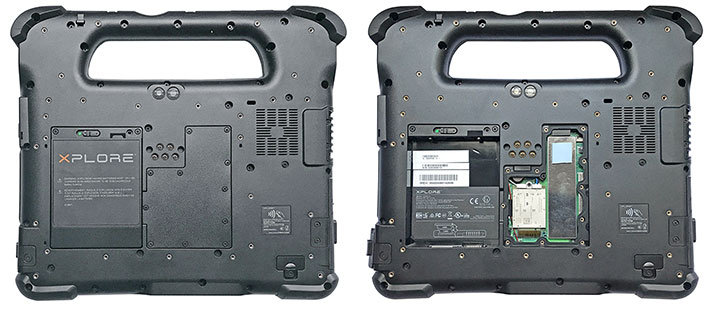
Unlike in the XSLATE D10 that had its battery underneath a cover bolted down with many small screws, the XSLATE L10 battery securely snaps into the backside of the tablet and is then locked in place. The springloaded sliding lock itself can be locked with a screw. The Li-Ion battery (7.6V, 4.770mAH, 36 watt-hours) has a rubber friction seal to keep dust and liquids away from the battery contacts and also the caddy with its dual micro-SIMs. Compared to its B10 predecessor, the L10's battery can be exchanged for a fully charged spare in seconds. No need to power down either; the L10 has an internal 3.1 watt-hour bridge battery that provides plenty of power even for a very slow battery exchange.
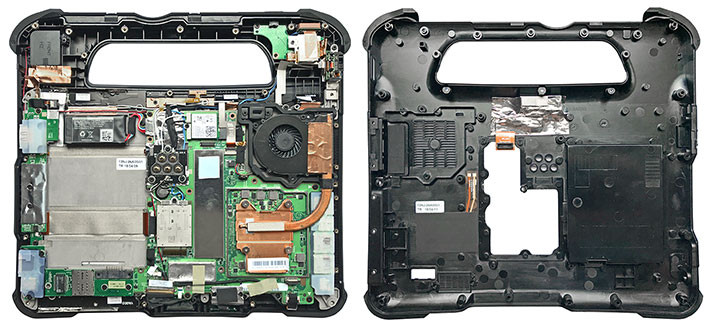
There are no wires and connections between the halves, again with the exception of the rear camera connector.
Like the XSLATE B10, the new L10 has a small fan as part of Xplore's internal thermal management system that also includes a custom copper heat spreader and heat piping to regulate heating and cooling in extreme temperatures. We'd rather not have a fan, but at this point it remains a necessity to guarantee safe operating temperatures and also guard against heat-related performance throttling. Xplore commented that the fan makes it possible for the XSLATE L10 to maintain full performance over the entire operating temperature range. Given that we've witnessed performance of some fanless designs drop dramatically when the system gets hot, including a fan makes sense.
There are cooling slots and vents on the housing, and those can be disconcerting as it looks like liquids can go right into the tablet's interior. That's not the case as the fan, which doesn't mind a bit of water, is mounted inside a sealed "enclave" inside the tablet.
A look at the inside of the L10 reveals a complex assembly of components, boards, connections, modules, shielding, securing, and mounting. Unlike in consumer tablets like the iPad where all electronics are integrated and hyper-miniaturized onto a singler tiny board, inside the L10 there is a full-function and very highly configurable and expandable PC. That means massive design logistics to meet all the goals and requirements, which include all the wired and wireless connectivity imperative in a mobile device. And that means antenna modules along the perimeter, outside of the mandatory electric shielding, and also a central point for optional external antenna pass-through.
Below a closer look at some of the interesting details of the L10 platform. From left to right the external antenna pass-through block, an example of the sealing of I/O blocks, and on the right the thermal management system with its heat pipe and fan.

Note that the antenna pass-through provides five antenna connections instead of the usual three. This gives customers the option of connecting dual LTE, dual Wifi, and one GPS antenna. This means full MIMO (multiple input, multiple output) dual antenna connection for both LTE and Wifi for best possible wireless performance, especially in areas with marginal coverage. According to Xplore, there currently is no another system that has this capability.
And more details below: On the left a closeup of the tongue-and-groove sealing method between the halves of the L10 case, the internal backup battery that allows hot-swapping of the main battery, and the tiny caddy for the two nanoSIMs.

All of this you find inside of the L10. Including clever solutions to eternal issues, such as how to provide industry-standard full-size I/O ports in a device that must provide as much ingress protection as possible. How did Xplore tackle this? With external plugs like everyone else, but also by encasing all those ports in translucent silicon jackets that seal against dust and liquids even when a port plug is not in place. Impressive.
Four processor options: from fast to ludicrous
It's hard to keep up with Intel's new process technologies, new processor generations, and never-ending flurry of new processors. For decades, the challenge has been to make gates — the essential building blocks of a processor — smaller and smaller so as to place more of them onto a tiny chip. Making them ever smaller and closer together also increased speed and lowered the power to drive the chips.
|
XSLATE L10 CPUs
|
XSLATE L10
|
XSLATE L10
|
XSLATE L10
|
XSLATE L10
|
|
CPU
|
Intel Core
|
Intel Core
|
Intel Core
|
Intel Pentium
|
|
Model
|
i7-8650U
|
i5-8350U
|
i5-8250U
|
N4200
|
|
Code name
|
Kaby Lake Refresh
|
Kaby Lake Refresh
|
Kaby Lake Refresh
|
Apollo Lake
|
|
Lithography
|
14nm
|
14nm
|
14nm
|
14nm
|
|
Cores/Threads
|
4/8
|
4/8
|
4/8
|
4/4
|
|
Base Clock Speed
|
1.90 GHz
|
1.70 GHz
|
1.60 GHz
|
1.10 GHz
|
|
Turbo Speed
|
4.20 GHz
|
3.60 GHz
|
3.40 GHz
|
2.50 GHz
|
|
TDP
|
15 watts
|
15 watts
|
15 watts
|
6 watts
|
|
Cache
|
8MB
|
6MB
|
6MB
|
2MB
|
|
Intel graphics
|
UHD Graphics 620
|
UHD Graphics 620
|
UHD Graphics 620
|
HD Graphics 505
|
|
Graphics base speed
|
300 MHz
|
300 MHz
|
300 MHz
|
200 MHz
|
|
Graphics max speed
|
1,150 MHz
|
1,100 MHz
|
1,100 MHz
|
750 MHz
|
|
Intel vPro
|
Yes
|
Yes
|
No
|
No
|
As of late, it's become increasingly difficult to make everything smaller yet, with process technology, generally defined as "half the distance between identical features in an array," now approaching the single digit nanometer range. So with their 6th, 7th and 8th generation of Core processors, Intel has mostly been optimizing and fine-tuning things. And to make things more confusing yet, Intel codenamed some of the chips in their 8th generation "Kaby Lake Refresh" and others "Coffee Lake."
There is, however, one big advance 8th generation ultra-low voltage mobile processors: they are for the first time available in quad-core configuration. Four cores, eight threads. 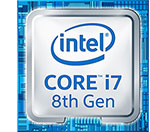 Xplore jumped on that advance with their new L10, giving the platform a distinct processing edge over systems using earlier generation dual core CPUs.
Xplore jumped on that advance with their new L10, giving the platform a distinct processing edge over systems using earlier generation dual core CPUs.
Maximum performance, of course, adds cost, not only due to the chip itself, but also due to supporting technology. So Xplore makes a lower-end L10 available as well. The Pentium N4200 chip Xplore chose is also a quad-core design, but this one has Intel Atom DNA and is part of codename "Apollo Lake" (which succeeded "Braswell" which succeeded the "Bay Trail" chip in Xplore's initial Bobcat tablet).
The reason why Xplore did this is not only to offer two distinctly different performance levels, but also to have successors for both the old XSLATE B10 and the old Bobcat. The B10 was roughly twice as fast as the Bobcat, and our guess is that Xplore wanted to migrate that performance ratio to the two versions of the new L10 platform.
To see how the two versions of the new Xplore XSLATE L10 perform compared to the B10 and Bobcat they are replacing, we ran our standard Passmark Software PerformanceTest 6.1, a suite of about 30 tests covering CPU, 2D graphics, 3D graphics, memory, and disk and then computes scores for each category and an overall PassMark score. The results are as follows:
|
Xplore Technologies XSLATE L10 Comparisons and Benchmarks
|
|
|
Xplore Technologies
|
Xplore Technologies
|
Xplore Technologies
|
Xplore Technologies
|
|
Model
|
XSLATE L10 (2018)
|
XSLATE L10 (2018)
|
XSLATE B10 (2015)
|
Bobcat (2014)
|
|
Processor Type: Intel
|
"Kaby Lake R" Core i7
|
"Apollo Lake" Pentium
|
"Broadwell" Core i5
|
"Bay Trail" Atom
|
|
Processor Model
|
8650U
|
N4200
|
5350U
|
E3845
|
|
CPU Speed
|
1.90GHz
|
1.10GHz
|
1.80GHz
|
1.90GHz
|
|
Turbo Speed
|
4.20GHz
|
2.50GHz
|
2.90GHz
|
No turbo
|
|
OS Software
|
Windows 10 (64-bit)
|
Windows 10 (64-bit)
|
Windows 8.1 (64-bit)
|
Windows 8.1 (64-bit)
|
|
Thermal Design Power (TDP)
|
15 watts
|
6 watts
|
15 watts
|
10 watts
|
|
BatteryMon min draw
|
3.0 watts
|
3.1 watts
|
4.5 watts
|
4.7 watts
|
|
PassMark version
|
v6.1
|
v9.0
|
v6.1
|
v9.0
|
v6.1
|
v9.0
|
v6.1
|
v9.0
|
|
CPU Mark
|
10,289.7
|
8,848.7
|
5,235.3
|
2,054.7
|
3,845.5
|
NA
|
1,924.9
|
NA
|
|
2D Graphics Mark
|
423.2
|
664.1
|
139.4
|
239.0
|
416.9
|
NA
|
149.2
|
NA
|
|
Memory Mark
|
2,613.7
|
2,297.6
|
672.8
|
1,040.7
|
1,241.2
|
NA
|
397.1
|
NA
|
|
Disk Mark
|
12,791.2
|
11,050.9
|
4,407.8
|
4,344.2
|
4,946.9
|
NA
|
2,513.9
|
NA
|
|
3D Graphics Mark
|
805.9
|
1,219.4
|
179.8
|
355.4
|
460.1
|
NA
|
158.0
|
NA
|
|
Overall PassMark
|
5,962.9
|
3,609.1
|
2,457.3
|
1,151.3
|
2,364.7
|
NA
|
1,133.8
|
NA
|
To say the results are astonishing would be an understatement. The overall PassMark score of 5,962.9 clocked by the 8650U-equipped version of the XSLATE L10 is far and away the fasted we've ever recorded with version 6.1 of the PassMark benchmarking suite. 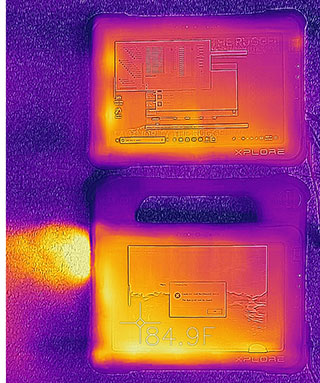 The presence of four processing cores, eight processing threads, and blisteringly fast PCIe-based storage perhaps combined to overwhelm PassMark 6.1's weighting that was likely calibrated for an era of hard disks and dual core CPUs. The presence of four processing cores, eight processing threads, and blisteringly fast PCIe-based storage perhaps combined to overwhelm PassMark 6.1's weighting that was likely calibrated for an era of hard disks and dual core CPUs.
The results are equally amazing for the lower-end Pentium N4200-equipped version of the L10. It actually beat Xplore's old high-end B10 in PassMark v6.1, even though that model was based on a genuine, powerful 5th generation Core processor. The relatively lowly (compared to the B10's Core i5-5350U) N4200 machine couldn't match the old B10 in graphics, memory and disk benchmarking, but ran away with it in processor performance, clocking a narrow overall victory over the B10.
So based on PassMark v6.1, the Core-based XSLATE L10 is easily twice as fast as the already quick Pentium-based version. And the new "low-end" L10 is as quick as the old "high-end" B10.
To cross-check, we also ran the PassMark 9.0 benchmark suite on both versions. There, the 8650U-based machine still clocked the, as of June 2018, highest score we've ever recorded at RuggedPCReview.com, although outscoring recent high-end Kaby Lake-based products by less of a margin.
The picture on the right was taken with our FLIR ONE Pro thermal imaging camera. It's an infrared picture of the Pentium N4200 version (top) and the Core i7-8650U version both running the PassMark benchmark suite. The higher thermal load of the powerful Core processor is plainly obvious, as is the heat emanating from its fan vent. That's the difference between a thermal design power of 6 watts and one of 15 watts.
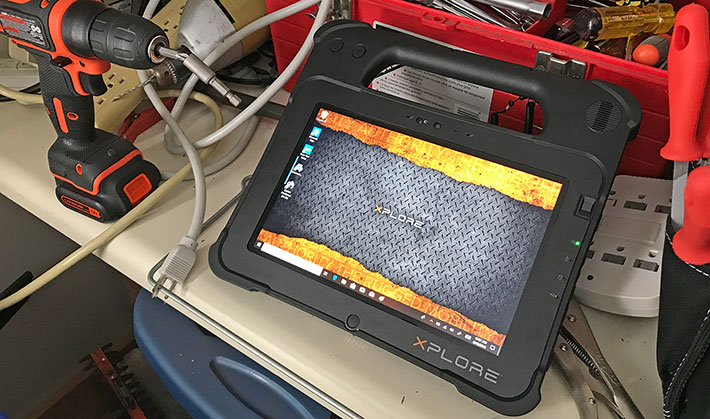
What that means is that the Core-based XSLATE L10 is a high-performance tablet for virtually any job, even complex, demanding ones. It actually beat our new 6-core Intel 8th generation "Coffee Lake" powered office Dell Vostro desktop with nVidia discrete graphics (the big Vostro, in fairness, had a handicap in its use of a rotating hard disk instead of solid state disk).
Very low power draw
Our two L10 pre-production evaluation units came with the standard battery that packs a modest 36 watt-hours. Xplore claims "up to 10 hours," which is a couple of hours more than the advertised battery life for the predecessor XSLATE B10. Given that the XSLATE is far more powerful than the old B10, can this be possible?
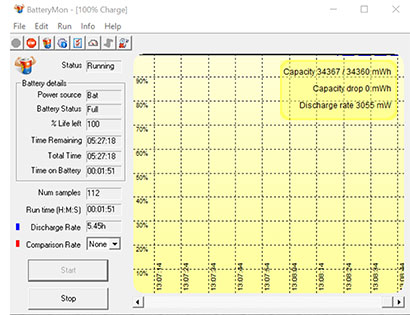 As always with Windows devices, we used PassMark's BatteryMon utility to measure power draw on the high-end Core i7-8650U version of the L10 with the 1,000 nits screen. As always with Windows devices, we used PassMark's BatteryMon utility to measure power draw on the high-end Core i7-8650U version of the L10 with the 1,000 nits screen.
Moving the new Windows 10 power slider all the way to "Best battery life" and the backlight setting to "Darkest," we saw as low as 3.0 watts. That's a full 1.5 watts less than the last XSLATE B10 we tested, and would translate into a theoretical battery life of 12 hours with the standard internal battery. With brightness set to "Suggested," power draw rose to 3.8 watts (theoretical 9.5 hours), and with the backlight set to "Brightest," draw rose to 6.7 watts (theoretical 5.8 hours).
Moving the power slider all the way to "Best performance" and toggling the backlight to "Darkest," we saw as low as 3.1 watts, which means about 11.6 hours. With brightness set to "Suggested" we saw 4.3 watts (theoretical 8.4 hours). Cranking the backlight up to maximum, draw rose quite a bit to 8.5 watts, good for a theoretical 4.2 hours.
We also did the battery drawdown test with the Pentium N4200 unit, also with the 1,000 nits screen. Interestingly, despite the much lower Thermal Design Power of just 6 watts versus the 15 watts of the Core processor, power draw was between 3% and 9% higher. This may be due to the more sophisticated power savings technologies in 8th gen Core processors or it could simply be an optimization issue in preproduction units.
Overall, given its very impressive performance, the L10 is also amazingly power-efficient. The minimum observed power draw is considerably less than what we had found in any prior Xplore tablet in this class. However, do note that while electronics are very power-efficient, full display brightness still significantly increases power draw and lowers battery life.
Finally, the usual qualifier: battery life is as relative as gas mileage in a car, or more so. Putting full, continuous load on the system will draw down battery power much more quickly.
Cameras
As stated in the opening summary of the L10 platform's features, camera resolution has been bumped up to 13-megapixel in the rear, and 2-megapixel webcam in the front. That's pretty much on par with modern smartphones, as it should be. For years, cameras integrated into rugged handhelds and tablets lagged way behind compared to what was available on phones. That never made sense to us. The purpose of such integrated cameras was to give a device another means of data collection, but they were rarely good enough for the job, necessitating using a dedicated camera anyway.
The L10 platform doesn't have that problem. The cameras are good enough for decent quality documentation. No need to whip out the personal smartphone. The pictures below show what you can expect from the L10 rear camera. Tap on the compilation for a full-size rendition.
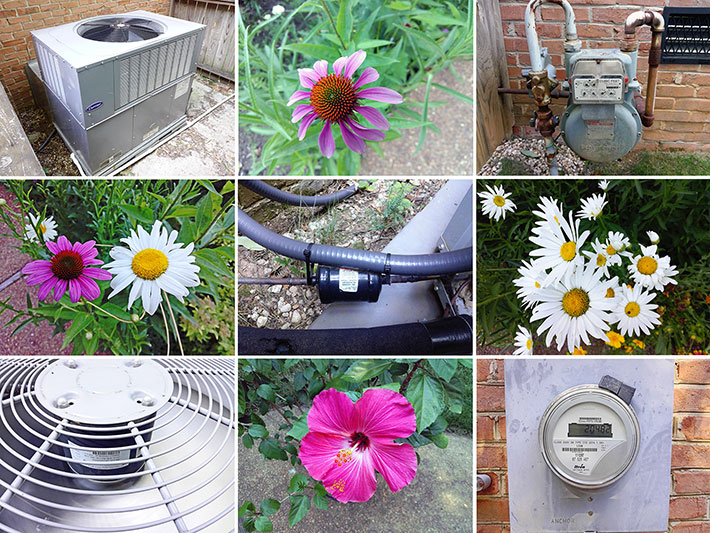
Unfortunately, the standard Windows 10 Camera app is very basic and in no way takes full advantage of either of the integrated cameras. We definitely recommend searching for a third party camera app.
Multi-touch vs. gloves and rain
Like the Bobcat and the XSLATE B10, the L10 platform uses projected capacitive touch, the same touch technology hundreds of millions love on their smartphones and tablets. Procap enables that effortless, smooth tapping, panning, pinching and zooming pioneered by the iPhone and iPad, something tablet users today instinctively expect from a tablet.
Initially, one problem with capacitive touch was that the technology works great when finger-tapping on a clean, dry screen, but not so well outdoors on the job with gloves on or in the rain. Since most Xplore customers use their tablets outdoors, Xplore early on provided their capacitive touch tablets with special "glove" and "wet" modes. On the XSLATE B10, modes had to be selected via a special control utility. In the new L10 platform, mode switching is automatic; the tablet senses conditions and adjusts sensitivity and calibration automatically.
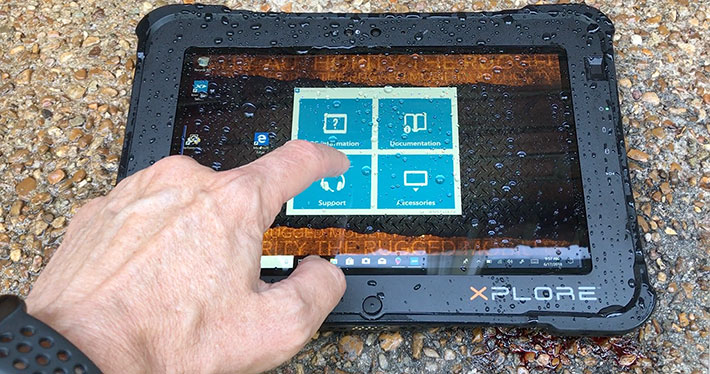
How well does it work? Given that it's a very difficult problem to solve, remarkably well. Rain and wetness is an especially difficult issue. Water is an excellent conductor and water sprayed or falling onto a touch screen will completely mess up measuring capacitance between electrodes. So the L10 may provides wet touch functionality by significantly decreasing the sensitivity of the touch controller and using a special screen protector that makes water pearl and bead enough so that there isn't uncontrolled conduction between different parts of the display surface.
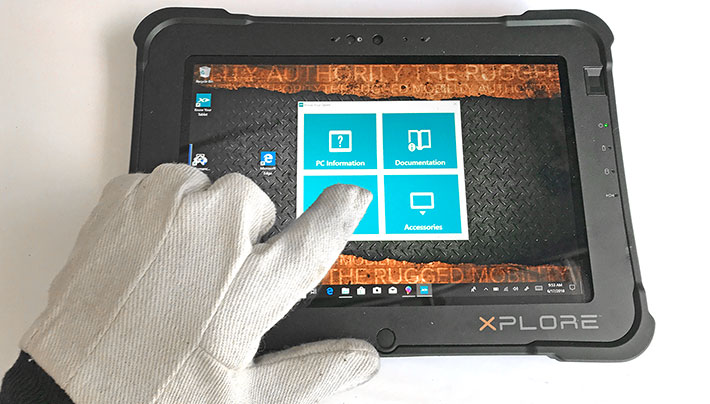
Using capacitive touch with gloves on is a different issue. Since capacitive touch is based on measuring the capacitance between two electrodes, if a glove gets between the finger and the display surface, the touch controller can't sense the finger and thus can't measure the capacitance. Xplore likely addressed that by increasing the sensitivity of the touch controller.
Don't expect perfection in those modes. Glove and wet touch is not for doing precision operations on the screen. But it is good enough to keep the tablet operational with touch-optimized custom apps.
Since Windows often requires more precision than a finger tap can provide, Xplore also offers a versions of the L10 with an active Wacom pen. Wacom pen technology is very mature and is very widely supported on Windows systems. The pens do not require a battery. Of the two pens shown below, the short one (3.5 inch) comes with the standard tablet version of the L10, the long one (5.5 inch) with the hard handle version. Each form factor provides a pen garage for storage, and also a tether.

As an alternate, Xplore also offer a battery-powered (AAAA battery) ePen that supports pressure sensitivity and has two mouse buttons. It is available in the XPAD or the XSLATE/XBOOK with the soft top handle accessory.
Ruggedness
Ruggedness — providing mobile computers that can operate in and survive harsh environmental conditions — is the core of Xplore's business. In general, unlike consumer electronics that are designed to be stylish, trendy, eye-catching and inexpensive to produce, rugged equipment is conceived and built around durability and ruggedness. Sometimes that comes the expensive of attractive, pleasing design.
The XSLATE L10, however, is an elegant device that exudes good industrial design. That isn't easy with tablets where the goal is to provide a good display in the thinnest, lightest package possible. The L10 communicates toughness with its materials, coloring and integrated bumpers and protection. It looks functional but never boring. But how much toughness did Xplore bake in? A lot.
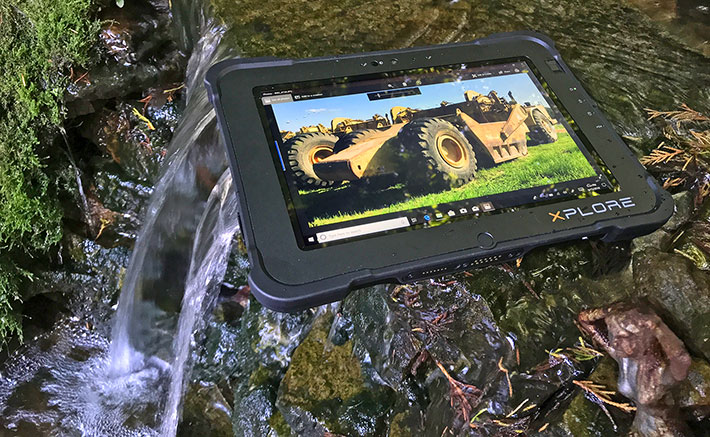
Any time you use a mobile computer out there in the field, there's the ever-present possibility that it may slip out of your hands and fall. Not onto carpeting like in an office, but onto concrete, gravel, rocks or worse.
The drop test described in Section 516.6 of the US MIL-STD-810G mandates an item to be dropped from four feet (the height a portable item is usually held while being carried or in use) onto every possible surface or edge or corner, for a total of 26 drops. The item does not have to be turned on, it simply must still work after each drop. And if it doesn't, the standard allows up to five items. As long as one makes it through the tests, it's a pass. That made no sense to Xplore. After all, out there in the field users won't have four spares. And the device may well be on when it falls. And there are tall folks, so a device may drop from higher than four feet.
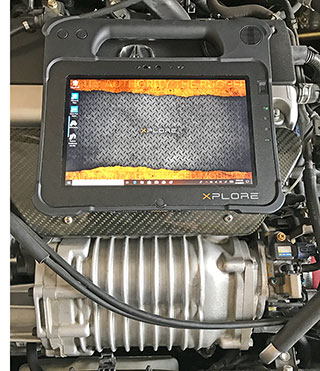 So Xplore did the test on a single unit that was on during the entire battery of 26 drops. And they did it from six feet. It passed. So Xplore did the test on a single unit that was on during the entire battery of 26 drops. And they did it from six feet. It passed.
In the field it can get very cold and very hot. The device must be able to handle that. The L10 tablet can operate in temperatures as low as -4 degrees Fahrenheit and as high as 140 degrees Fahrenheit (-20 to +60 Celsius), enough for virtually any conceivable deployment.
Sealing is important in a rugged machine as dust can gum up the works, and water can render a computer inoperable or destroy the electronics completely. Xplore claims IP65 for the XSLATE L10, where the "6" stands for being dustproof and the "5" for the ability to handle low pressure water jets from all directions.
The XSLATE L10 does have a fairly large number of exterior openings for all of its slots, ports, connectors, and batteries. That means a large number of seals that must be in perfect condition, and protective doors that must have intact seals and must be closed carefully. Xplore knows that and, in response, sealed all of the unit's ports from the inside. That way, frequently used protective doors can remain open and accommodate cabling while still providing full sealing.
As always, your particular application will make the ability to pass some of those tests either vital or meaningless. Xplore provides more, and more thorough, ruggedness testing specs than most, so anyone interested in the XSLATE L10 should examine them closely and also check with Xplore for additional test results.
Bottom line: Xplore L10 rugged tablet platform
It's fair to say that with the L10 platform, Xplore Technologies has evolved the tablet form factor to a next level. 2-in-1 and hard handle versions of tablets are not new, but to offer them all in integrated variants of one platform, that we haven't seen before. Add to that an exceptionally wide range of performance scaling, and the Xplore L10 tablet ecosystem has an awful lot to offer.

The basic L10 tablet is visually almost identical to Xplore's older and existing 10-inch class tablets, but that's misleading as the L10 is a far more powerful design. A trio of Intel 8th generation "Kaby Lake Refresh" Core processor provide the kind of performance many field professional need for complex work. If that's not needed, a low end Intel Pentium-based version is still as fast as the old high-end Xplore XSLATE B10. And despite its considerable ruggedness thanks to a tough magnesium alloy frame, polycarbonate housing, and elastomer corner and edge protection, the handy tablet weighs under three pounds. With a footprint barely larger than an iPad, the XSLATE L10 fits virtually anywhere.
The L10's 500 or 1,000 nits 10.1-inch 1920 x 1200 pixel IPS display with near perfect viewing angle from all directions is bright and easy on the eyes, indoors and out. It does a decent job controlling reflection and remaining usable even in bright sunlight. Using capacitive multi-touch, Xplore also baked in automatic switching between "glove" and "wet" modes. Also available are active pen versions that provide the kind of precision needed for certain applications.
The XPAD version of the L10 addresses the needs of customers who like a hard handle with integrated scanner and programmable buttons. And the XBOOK version turns the L10 tablet into a full-function laptop replacement with its well-matched detachable keyboard and kickstand.
Combined with available PCIe-based storage, all three of the available high-end Intel 8th generation Core processors provide exceptionally high performance (as of this writing, mid-June 2018, the highest we have tested). Wireless communication is state-of-the-art with 802.11ac WiFi, Bluetooth 4.2, and available Sierra 7565 4G LTE mobile broadband.
With the XSLATE L10, Xplore Technologies now offers mobile professionals the choice of various form factors and various performance levels in one compact, elegant, lightweight and very compelling tablet platform. -- Conrad H. Blickenstorfer, June 2018
|
Xplore Technologies XSLATE L10 Specifications
|
| Type |
Rugged Tablet PC platform with XSLATE, XPAD (integrated handle), and XBOOK (2-in-1 keyboard) form factors
|
| Introduced |
June 2018
|
| Processor |
Quad-core Intel Core i7 8650U (8th gen "Kaby Lake Refresh)
Quad-core Intel Core i5 8350U (8th gen "Kaby Lake Refresh)
Quad-core Intel Core i5 8250U (8th gen "Kaby Lake Refresh)
Quad-core Intel Pentium N4200 ("Apollo Lake")
|
| CPU speed |
Core i7 8650U: 1.90GHz/4.20GHz max turbo
Core i5 8350U: 1.70GHz/3.60GHz max turbo
Core i5 8250U: 1.60GHz/3.40GHz max turbo
Pentium N4200: 1.10GHz/2.50GHz
|
| Thermal Design Power |
Core processors: 15 watts, Pentium 6 watts
|
| Graphics |
Core processors: Integrated Intel UHD Graphics 620; Pentium: Intel HD Graphics 505
|
| OS |
Windows 10 Professional (64 bit)
|
| Memory |
4GB (Pentium N4200 only)
8GB (Pentium N4200 & Core i5 8250U only
16GB (Core i5 vPro 8350U & Core i7 vPro 8650U only)
|
| Display |
10.1-inch/1920 x 1200 pixel (16 : 10 aspect ratio, 220 ppi), direct-bonded IPS TFT, 178-degree viewing angle, 500 or 1,000 nit
|
| Digitizer |
Standard display: capacitive multi-touch, 500 nits, or
ViewAnywhere display: capacitive multi-touch 1,000 nits, or
ViewAnywhere display: capacitive multi-touch 1,000 nits with active Wacom pen
| Keyboard |
Onscreen; optional external |
| Storage |
Core i5 and i7 CPUs: 128GB SATA SSD, 256GB / 512GB / 1TB PCIe SSD
Pentium CPU: 64GB / 128GB / 256GB / 512GB SATA SSD
|
| Expansion slots |
1 x Micro SDHC card slot, 2 x Nano SIM (4FF), optional CAC/SmartCard reader
|
| Housing |
Lightweight magnesium alloy internal frame, polycarbonate housing, contoured bumper protection and rubber door protection for ports |
| Size |
XSLATE: 11.1 x 7.7 x 0.88 inches (281 x 195 x 22 mm)
XPAD: 11.1 x 10.0 x 0.88 inches (281 x 256 x 22 mm)
XBOOK: 11.1 x 10.0 x 0.88 inches (281 x 256 x 22 mm)
|
| Weight |
XSLATE: 2.9 lbs (1.31kg) with standard battery and pen
XPAD: 3.26 lbs (1.48kg) with standard battery and pen
XBOOK: unknown
|
| Operating temperature |
-4° to 140°F (-20° to 60°C) |
| Ingress protection |
IP65 (IEC 60529)
|
| Altitude |
40,000 feet for 1 hour, operating. MIL-STD-810G, Method 500.5, Procedure II |
| Humidity |
3% to 95% non-condensing, 30°C to
60°C, 5 cycles of 48Hr
|
| Salt Fog |
Unknown
|
| Drop |
Operating: 6 foot (183cm) drop 26 times onto plywood over concrete, all on 1 unit |
| Vibration |
Minimum Integrity Non-operating, Composite Wheel Operating
|
| ESD/EMC |
FCC Part 15 B, Class B; CAN/CSA ICES-003, Class B; EN55032, Class B; EN 301-489-1, 301-489-17, 301-489-24, 61000-3-2, 61000-3-3, EN55024, EN 303 413
|
| Intrinsic safety |
ANSI/ISA 12.12.01-2013
|
| Power |
Li-Ion 7.6V, 4.770mAH, 36 watt-hours ("up to 10 hours"), optional extended battery Li-Ion 98 watt-hours ("combined up to 27 hours") |
| Cameras |
Integrated 13 megapixel camera with flash (rear), integrated 2 megapixel FHD camera (front) |
| Security |
Integrated fingerprint reader, Trusted Platform Module (TPM) 2.0, optional CAC / SmartCard reader, Computrace, removable SSD panel |
| Interface |
2 x USB 3.0, 1 x RJ45 gigabit LAN, 1 x USB Type C (USB 2.0, USB 3.0, Display Port out), audio in/out; optional: 1 x HDMI-in OR 1 x native serial RS232 port, dock |
| Wireless |
Intel Dual Band Wireless-AC 8265 + Bluetooth V4.2 (EDR + BLE), NFC; optional internal Sierra Wireless EM7565 4G LTE with GNSS (GPS + GLONASS + Galileo + Beidou) OR discrete u-blox GNSS (GPS + GLONASS with SBAS (WAAS, EGNOS and MSAS)), optional pass-through antenna includes five ports for MIMO WWAN, MIMO WLAN and GPS
|
| Price |
Starting at $2,199 (Pentium units) and $2,849 (Core processor units) |
| Web page |
Xplore XSLATE L10 platform |
| Brochure |
 Xplore XSLATE L10 spec sheet/brochure Xplore XSLATE L10 spec sheet/brochure |
| Warranty |
Standard 3-year warranty, 4 and 5 year options, optional xDefend program |
| Contact |
Xplore Technologies
14000 Summit Drive, Suite 900
Austin, TX 78728, USA
Toll Free: 1-888-449-7567
Phone: 1-512-336-7797
Fax: 1-512-336-7791
info@xploretech.com
www.xploretech.com
|
|
(copyright 2018 RuggedPCReview.com)
|
|



